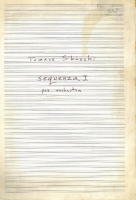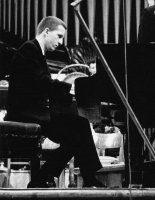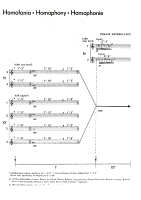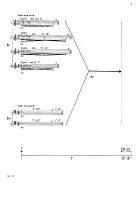Tomasz Sikorski’s oeuvre acquired individual traits around 1963, when the composer made his Warsaw Autumn debut with Antiphons. The piece as well as most works written in the 1960s were part of the then dominant trend in music – sonorism. Sikorski drew on fashionable models, although from the very beginning his works had their own distinctive identity. The popularity of sonorism undoubtedly created favourable conditions for him. Referring to it, he could present his own, original approach to music, aimed at not only searching for new sounds and colours, but going also a step further, i.e. towards the nature, essence of sound.
At that time he was fascinated with several sonic phenomena like attack and sustain, swelling and fading of sound, resonance and flow of sound through space. His interests stemmed naturally from his sensibility. They were not a result of profound reflections, calculations or speculations. His artistic honesty was immediately noticed and appreciated. Young Tomasz Sikorski quickly managed to spread his wings.
The core of his oeuvre from that period is made up of five works (Antiphons from 1963, Echoes II from 1961-63, Prologues from 1964, Concerto Breve from 1965 and Sequenza I from 1966) written for orchestra or relatively large and varied ensembles. They always include the piano (or two pianos in the case of Prologues). In addition, the composer uses voices (choir and soloists) as well as sounds recorded on tape and processed in the studio. The multiple-page, dense scores of these pieces are markedly different from the very sparse notation used by Sikorski in his later, mature works.
The composer uses novel playing techniques and methods of sound production (e.g. enharmonic glissandos, ondulazione and vibrazione on brass instruments), as well as unusual instructions for performers, like playing the highest or the lowest possible note, touching the edge of a vibrating cymbal with a metal stick, striking with the piano fallboard, playing the piano with a ruler placed on its strings, slowly moving the bow over the strings in order to create a grinding effect or soundlessly pressing as many piano keys as possible.
He very frequently uses non-standard tempo or time markings: gradual acceleration until the piece is played as quickly as possible (accelerando liberamente sino al più presto possibile) and gradual slowing down from playing as quickly as possible (ritardando liberamente dal più presto possibile), playing as quickly as possible (il più presto possibile), entering with a slight anticipation or delay, playing the same material in different tempi, specifying the time frame for a given fragment or duration of a pause. Usually, the principle of vertical synchronisation does not apply in works written in that period. In addition, the composer sometimes provides guidelines as to the layout of the performing forces.
Significantly, already in the 1960s Tomasz Sikorski organises the musical material in rows, putting together sound modules or making them overlap. The modules are created within uniform instrument groups: the woodwind, the brass, the strings, the percussion, the piano or the choir, which is always treated like a powerful homogeneous instrument.
Clashes of sound qualities, typical of sonorism, gradually give way in Sikorski’s works to a search for shared sound elements, a search for a shared sonic denominator for the various instrumental groups. Sikorski follows a direction opposite to the one followed at the time by most Polish composers, who focused on expanding the available sound palette, discovering new, hitherto unknown sounds. Instead, he seeks to discover the nature, depth and structure of sound – its ultimate cause.
This direction will determine his artistic path, which he will follow in a consistent and uncompromising manner. Bearing in mind the artistic choice made by the composer, we can easily understand why in his later works he seeks to reduce the musical material so much. The aesthetic foundation of such choices, their source and even sound effect are thus fundamentally different from the foundation of American minimalism, with which scholars used to associate some of the techniques used by Sikorski.
Sikorski definitely abandons sonorism in the early 1970s, though the turning point is by no means very clear. For example, in 1971 he wrote Vox Humana, a piece still rooted in the previous aesthetics. On the other hand, the composer ‘tested’ new ideas as early as in the 1960s, using the instrument he knew best, namely the piano. It has to be noted in this context that it was precisely the piano and its sound that had the decisive influence on the development of Sikorski’s musical language in every period of his work. In 1967 Sikorski wrote Sonant, a piece announcing radical changes. Short sound modules undergo slight transformations here, as if they were about to lose their distinctness, though at the same time they do not become similar. Sikorski’s aesthetic transformation is also heralded by Diaphony (1969) for two pianos, a work created basically of sound ‘snatches’. A bridge between the ‘old’ and the ‘new’ is provided by Homophony, a work written in 1968-69.
We are dealing here with a toning down of sharp contrasts, much lesser inner vibration of sound modules and greater focus on those sound qualities that bring together seemingly distant sounds. These elements begin to occupy a central place in the composer’s creative experiments.
Tomasz Sikorski won recognition already with his first compositions presented to a wider audience. They testified not only to his excellent knowledge of the secrets of composition, but also to his original approach to the sound matter. Sikorski’s music is directly derived from the composer’s fascination with the phenomenon of echo. In his works – both Echoes and Antiphons – he was interested primarily in the aspects of sound hitherto regarded as secondary. Music drawing on the echo phenomenon became a distinctive feature of Sikorski’s oeuvre.
This is how Andrzej Chłopecki commented on the appearance of the young composer in Poland in the 1960s:
In the orgy of clusters and murmuring sounds, sonic cascades and energetic percussion eruptions Tomasz Sikorski’s voice sounded different. It was not until ten years later, in the mid-1970s, that the aesthetics announced by Tomasz Sikorski – the aesthetics of minimal music – conquered the Warsaw Autumn stage.








